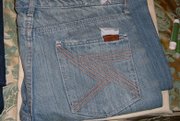Fashion Focuses on the Price of Fakes
Los Angeles’ fashion industry loses $617 million every year because of counterfeiting, according to the Los Angeles County Economic Development Corp.
The impact of counterfeiting was on the slate at an Aug. 22 forum titled “The True Costs of Fashion Counterfeiting,” hosted by the U.S. Chamber of Commerce, the California Fashion Association, Fashion Business Inc. and the Fashion District Business Improvement District. The seminar was part of a nearly week-long program sponsored by the U.S. Chamber to put the spotlight on the impact of counterfeiting and efforts to stop counterfeiters.
Held at the California Market Center, the forum featured a panel of experts who recommended different avenues designers could take to protect themselves from counterfeiting.
The panel included attorney Douglas Lipstone, an attorney with Los Angeles–based Buchalter Nemer; Kris Buckner, a private investigator specializing in combating fashion counterfeiting, and president of Lawndale, Calif.–based Investigative Consultants; Jeffrey Banks, a New York–based designer and executive board member of the Council of Fashion Designers of America; Jack Jay, director of Los Angeles buying office IBS Corp.; Ron Perilman, vice president of sales at Los Angeles–based Tummy Tuck Jeans; and Michael Rosen, chief operating officer of Los Angeles–based fashion brand Michael Stars.
Rosen recommended companies carefully monitor their supply chain to make sure that offshore contractors producing their designs aren’t making additional units to sell out the back door. Rosen also recommended security labels, which helps a company distinguish between an authentic product and a convincing counterfeit.Yet the discussion of counterfeiting and its impact on the fashion industry was quickly eclipsed by the hot-button issue of a proposed federal copyright law designed to protect fashion.
The terms “counterfeiting” and “copyright infringement” are often confused. Counterfeiting is the unapproved use of a company’s trademark, which can include the brand name or logo, such as Nike’s swoosh, or distinguishing marks, such as Adidas’ triple stripe.
Copyright infringement is currently limited to textile print and pattern or surface treatments such as embroidery. The proposed Design Piracy Prohibition Act would extend copyright protection to clothing and accessories if it were passed.
The design-piracy law was first proposed last year. The law was re-introduced to the U.S. House of Representatives in April and to the U.S. Senate on Aug. 20. It has been endorsed by the CFDA and, in particular, the organization’s president, Diane von Furstenberg.
At the Aug. 22 panel discussion, both counterfeiting and copyright were discussed. And while fashion-industry leaders agree that counterfeiting exacts a heavy toll on legitimate brands, there was no consensus on the proposed copyright law, with some saying it will help the designers and others arguing that the fashion industry will suffer if the law is passed.
Banks, a CFDA member, said that the proposed design piracy law, if passed, will protect designers because they could officially register their designs with the U.S. Copyright Office. The registration would give them a tool against companies that openly copy existing designs.
“This would not eliminate the problem,” he said. “But it would act as a deterrent for companies who’ve had their whole livelihood based on other people’s designs.”
Buchalter Nemer’s Lipstone argued that a certificate would have a “chilling effect” on the industry. Risk-averse factors would either not loan designers funds to produce clothes or limit the amount they loan to a manufacturer. And if that happened, Lipstone cautioned, small- and mid-size designers could go out of business.
Among the audience members was Alain Coblence, an attorney who represents the CFDA and helped draft the Design Piracy Prohibition Act.
Coblence contended that the proposed law will shield from prosecution those who were ignorant of working with a counterfeiter.
“The law specifically excludes retailers, distributors and importers who have acted without knowledge [that a design has been copied],” he said.
Lipstone also argued that it would be too difficult to determine authorship of a specific design. Banks countered that the “personal vision” of a design would be eligible for copyright protection. For example, while a blazer could not be copyrighted, a designer’s specific vision of a blazer could be registered as a copyright, he said.






















